David O. Stewart's Blog, page 7
December 24, 2013
“The Lincoln Deception” on Audible.com
Audible.com has finally listed the audiobook version of The Lincoln Deception, narrated by L.J. Ganser. I’m a huge fan of audiobooks, and listen to them all the time in the car, even on very short trips to the market or the gym.
Right now I’m near the end of the audio version of Bernard Cornwell’s 1356, a chronicle of 14th-century slaughter at the Battle of Poitiers which I am enjoying immensely. I think Cornwell is quite wonderful — the Sharpe series, in particular, is a fantastic depiction of Napoleonic times — but a good reader adds to the distinctiveness of characters and the depth of dialogue. Jack Hawkins, who reads 1356, is very good.
Some authors read their own books, but I tend to avoid those. A good actor will almost always be a better reader, in my opinion, than the writer. I remember being struck particularly by a reader on a Roddy Doyle book; the rhythm of Irish dialogue was so much stronger for me when spoken by an Irishman (or someone who can do a good Irish accent).
I have heard only a snippet of L.J. Ganser‘s reading of The Lincoln Deception, but it sounded remarkable to me. If you have the time and opportunity to listen, I find it adds pace and drama to a story. Ganser has also read several novels by James Ellroy and Russell Shorto’s book about Dutch New York, The Island at the Center of the World.
December 12, 2013
The Booth Conspiracy hits CSPAN 3 on Sunday night, December 15
My talk about the John Wilkes Booth Conspiracy to the Virginia Historical Society in Richmond will be aired on CSPAN 3 this weekend at 9 p.m. on Sunday, December 15, and then again at midnight. It was a great turnout and a terrific audience. I have learned that Virginians pay attention to history.
The title for the talk was “Family of Assassins: The Surratts of Maryland,” which CSPAN has revised to “The Conspiracy Behind the Lincoln Assassination.” Fine.
As a small teaser, I offer the images of the mother-son conspirators, Mary and John Surratt, Jr. Not so many mother/son criminal combinations in our history. . . .

John Surratt, on the lam from the Lincoln assassination, as a soldier in Pope Pius IX’s Zouave unit in Rome. I could not make that up.
[image error]
Mary Surratt, who “kept the nest that hatched the egg of assassination,” in Andrew Johnson’s vivid phrase.
October 21, 2013
Killing Them Softly
Death plays a big role in most history books, and definitely in biographies. The death of a central feature often concludes a book. Even if the book’s story ends before the main characters shuffle off this mortal coil, readers want to know how it all ended for the people they have spent several hours reading about, which usually leads to an epilogue.
This question is on my mind because I’ve just written of the death of James Madison, for my current nonfiction project (aiming at publication in the second half of 2014, if all goes well). I find that writing about a character’s death is important to my views about a figure. Death is a great leveler. We arrive in life naked and leave it the same. How people meet their deaths, and the reactions of those close to them, is significant.
I first confronted these issues in my second book, Impeached, about the Andrew Johnson impeachment trial in 1868. I had to examine the deaths of the two great protagonists of the impeachment struggle: Rep. Thaddeus Stevens and President Johnson.
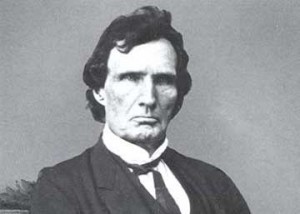
Rep. Thaddeus Stevens
Just weeks after the conclusion of the impeachment trial, Stevens passed from this world with characteristic flourishes. He wisecracked — when a visitor told him he looked well, Stevens replied, “It’s not my appearance that troubles me. It’s my disappearance.” His longtime African-American housekeeper and presumed lover, Lydia Smith, sat vigil at the foot of his bed, ever faithful. And he left instructions that he be buried in a cemetery in Pennsylvania that accepted whites and blacks alike, making his death a teaching moment for the nation. Virtually the entire town of Lancaster lined the streets for his funeral procession. I admired Stevens all the more.
Johnson’s death in 1875 offered a characteristic flourishes, too, but also softened my generally unfavorable view of him. He died shortly after winning a seat in the U.S. Senate from Tennessee, climaxing a five-year battle to return to public office; Johnson never stopped being a tough hombre. He directed that he be buried with his head on the copy of the Constitution he carried with him through life, and wrapped in the American flag. There’s a bit of grandiosity there, but strength of character, too. And his daughter faithfully attended him through his final days after a stroke laid him low.
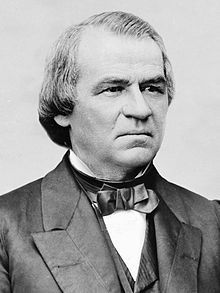
President Andrew Johnson
For my next book, American Emperor, I could find little about the final days of Aaron Burr. Since the book was published, a wonderful account of the final summer of his life in 1836, from a contemporary diary, has been published by Martha Smith Kakuk and Ray Swick of Blennerhassett Island State Park. I wish I had been able to use it. It shows the loneliness of Burr’s last months, with only a cousin and a paid attendant to look after him through powerful mood swings and the frustrations of declining health and strength. It is a poignant picture of Burr, something of a corrective to his generally negative reputation, yet shows also the isolation that he created for himself.
 James Madison’s demise in 1836 was, appropriately enough, best chronicled by his slave valet, Paul Jennings. For a man who lived in the midst of slavery all his life, who thought it an abomination, who worried that slavery would destroy the nation, and who never figured out a way out of slaveholding for the nation or for himself — of course, a slave would be the one to record his final moments. The only other person present was a cherished niece. It was a quiet end, one that fit a quiet man who moved the world.
James Madison’s demise in 1836 was, appropriately enough, best chronicled by his slave valet, Paul Jennings. For a man who lived in the midst of slavery all his life, who thought it an abomination, who worried that slavery would destroy the nation, and who never figured out a way out of slaveholding for the nation or for himself — of course, a slave would be the one to record his final moments. The only other person present was a cherished niece. It was a quiet end, one that fit a quiet man who moved the world.

Paul Jennings, slave valet to James Madison
September 17, 2013
Washington Navy Yard: Some Tough History
For someone writing a book about James Madison (that’s me), yesterday’s mass shooting at the Washington Navy Yard has powerful echoes. While the new national capital was being hacked out of forest and swamp in the 1790s, Congress arranged to buy land for a naval support facility. Soon the navy yard at Washington City was the center of America’s small but tough fleet of armed frigates and smaller warships.
(For a great history of the early Navy, check out Ian Toll’s Six Frigates.)
Perhaps the enduring image of the Navy Yard has been when Navy Secretary William Jones personally supervised its destruction in late August 1814, in order to keep its valuable stores and munitions from falling into the hands of the invading British Army. British troops burned down the Capitol and the Executive Mansion, but the American forces blew up the Navy Yard. Not a glorious day for American arms.
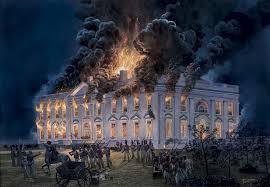
Washington’s Executive Mansion ablaze in late August 1814
Through Madison’s second administration, Navy Secretary Jones was an oasis of competence in a desert of Cabinet ineptitude. Madison later called Jones the best Navy Secretary the nation had known. Since there had only been a handful at the time, one of whom was a known alcoholic, the praise rang more hollow than it should have. While the army stumbled and bumbled its way through much of the War of 1812, the Navy won victories on the Atlantic and the Great Lakes that buoyed the nation’s morale in very dark days.
Like many folks in the DC area, I have my own connection to the Navy Yard. For a month in the summer of 1971, I worked there at a Veterans’ Administration office. My job, with about a dozen other white college students, was to file IBM punch cards in alphabetical order in about 50 massive file cabinets; because the cards were not in alphabetical order, we crisscrossed the flourescent-lit storage space, dragging out file drawers and flipping through them to find the exact correct space to file “Stewart, Daniel H.” between “Stewart, Daniel G.” and “Stewart, Daniel I.” Mind-numbing, in the extreme.
Managers instructed us to file 800 cards a day. Working feverishly, I barely could file 400. Towards the end of my first week, a longtime employee gave me a sidelong glance as she listlessly pawed through a file cabinet.

IBM punch card
“Honey,” she said, “you working way too hard.”
“But they said we had to file 800 a day,” I protested.
“Two hundred is plenty.” She slammed her drawer shut for emphasis.
I looked around the room. It had all the energy of a vacant lot. The year-round employees sashayed around, chatted, left for the rest room for remarkably long breaks. For the next three weeks, I brought a book to work with me. Every hour, I took a 15-minute break in the men’s room to read with the other shirkers. I read The Brothers Karamazov in that rest room.
After a month on the job, I quit to volunteer at Sen. George McGovern’s office. I just walked in and they put me to work. McGovern was preparing to run for president in 1972 as the antiwar candidate. I wanted to end the Vietnam War, and McGovern seemed the best way to make that happen. After two months working for him, I had developed a different form of disillusion — a story for another day –and decided to go back to college.
But my month at the Navy Yard has always stuck with me. All that empty work and those people who hated their jobs. And now this terrible shooting. So sad.
September 6, 2013
John Bingham: American Founding Son
Today marks the launch of a new biography of Congressman John Bingham of Cadiz, Ohio, American Founding Son, by Gerard Magliocca of University of Indiana School of Law. It’s great to have this fresh and excellent examination of Bingham, a key force in helping to shape the America that emerged from the Civil War:
Bingham is the source of the largest single expansion in the rights of citizens since the Constitution was ratified: the commitment to “equal protection of the laws” and “due process of law” embodied in Section 1 of the Fourteenth Amendment. Without those provisions, the federal government might never have had the power to support the civil rights movement over the last sixty years.
Bingham was a critical leader in the effort to impeach and remove from office President Andrew Johnson, as detailed in my book, Impeached. Without Bingham’s support, the impeachers never would have gotten their resolution out of the House of Representatives. On the noteworthy but perhaps less admirable side of the ledger, he gave a 12-hour closing statement that was difficult to wade through in print and must have been agony to sit through — though contemporary accounts claimed that he appealed so powerfully to the emotions of the Civil War that he reduced those in the House galleries to a flood of tears.
Bingham also was the lead prosecutor in the 1865 trial of eight of John Wilkes Booth’s co-conspirators in the Lincoln assassination, which led to an incendiary disclosure he made on his deathbed which is the trigger for my recent historical mystery, just published last week, The Lincoln Deception.
Magliocca, a prolific writer, also has written about William Jennings Bryan and Andrew Jackson. I welcome his nonfiction treatment of Bingham as a worthy complement to The Lincoln Deception.
This fall, it’s all Bingham, all the time!
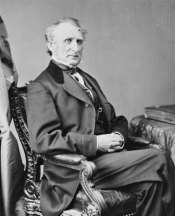
Congressman John Bingham of Ohio
July 17, 2013
E-Books and Libraries: Not So Fast!
The Montgomery County Council, which presides over my home jurisdiction and which includes my favorite person (my wife Nancy), is considering a resolution demanding that various state and federal government organs act immediately to ensure that the county’s library users have access to e-books in a “reasonable and non-discriminatory manner.”
The only problem with this resolution is that County residents already have exactly such access. What the resolution sponsors want is specially-advantaged access that discriminates against everyone else. I have submitted the following statement on this subject for the public record:
“Traditionally, the publishing industry, and writers, have subsidized the public library system, a system that is undeniably socialist. A single library book, which may generate $2 in revenue for a writer, can be loaned out dozens of times. At least some of those borrowers were likely to have purchased the book, but writers and publishers have been willing to forego that income because of their largely sentimental wish to support public libraries. Many writers have fond memories of libraries of their youths, where their love of the written word was nourished. Similarly, writers and publishers forego revenues altogether in the making of recorded books for the blind.
”E-books, however, raise special problems. A library book will eventually become too tattered to continue lending. If it is a popular volume, the library will buy another. That never happens with e-books. They never degrade. They are perpetual. That harms writers directly.
“Different publishers have taken different approaches to the problem of library distribution of e-books. Some simply refuse to sell e-books to libraries. Others charge premium prices for e-books. Others will license an e-book only for a specified number times it may be loaned out: for example, the license may expire after 26 times being loaned.
“These responses to the problem of library distribution of e-books are neither discriminatory nor wrong. They respond to a special problem presented by the lending of e-books for free. What other products in our world are given away for free? Does Microsoft give away its software? Does Exxon give away its gasoline? Does the library get its furniture for free?
“Moreover, with digitization, the economics of the publishing industry are in wild flux. Authors’ incomes are declining because authors earn less on e-books than on physical books. Other negative forces are the disappearance of retail outlets for books, not to mention the shrinkage and disappearance of book reviews in magazines and newspapers.
“Article 1, Section 8, clause 8 of the U.S. Constitution specifically provides for a system of copyright protection for the creations of authors because the Framers recognized that a vibrant political and civic culture requires that authors receive fair compensation for their work, and that the written word is uniquely vulnerable to being stolen. Books are the means for sharing the most important ideas of our time: in politics, in science, in history, in culture, and in the lives of our imaginations. If those who write books do not receive fair compensation — as is true in modern Russia and China, where book piracy is pandemic – the book culture will shrivel and die, leaving a nation that is poorer in ideas and understanding.”
Oh, and Nancy Floreen is NOT sponsoring this resolution, though she does dress up a blog post!
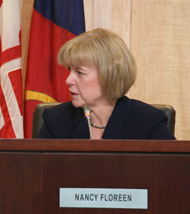
Nancy Floreen, Montgomery County Council
June 24, 2013
Aaron Burr on Staten Island

Aaron Burr in his later days.
Aaron Burr’s final days on Staten Island are the subject of a delightful new volume by Martha Smith Kakuk and Ray Swick: Aunt Abby and Aaron Burr’s Last Days: Staten Island, the Summer of 1836, and the Death of America’s Most Notorious Man.
Brought out in a limited addition by the Printing Press, Ltd. of Charleston, West Virginia, the pamphlet features the poignant reminiscences of Abby Bailey, who befriended Burr at a Port Richmond hotel during his last summer on earth. Though there has always been something shabby and seedy in the portrayal of Burr’s final months, Bailey emphasized that the inn was a pleasant one on the shore that afforded views of the steamers and other craft going by, and Burr’s room was “the pleasantest of the house.”
Burr was largely attended by a woman servant, whom he addressed as the “Irish devil,” who carried him easily; never a large man, age and decrepitude had shrunk him. Bailey describes the 80-year-old Burr as subject to many of the indignities of age, subject to pettishness when not attended to, but also still capable of “acting the finished gentleman.” The saddest part of Burr’s situation, as Baley writes, was that he had no surviving family to be with him during his final days.
Though Bailey’s reminiscence is relatively brief, it provides a view into a period in Burr’s life that was largely a blank. History writing involves putting together lots of small pieces like this, and I’m grateful to Kakuk and Swick for making this one available.
I offer a final note about Swick, the historian of West Virginia State Parks. He has produced several volumes that preserve fascinating moments in history, including: a book on Blennerhassett Island in the Ohio River, where Burr’s Western expedition formally began; and a terrific first-person account of a journey down the Ohio and Mississippi Rivers in 1803, A Journey Through the West. I’m glad to have the opportunity to thank him for his work, and pay tribute to it.
June 17, 2013
Looking for America in World War I
On a recent trip to France, as part of research for a novel I hope to write next year, my long-suffering wife endured several days in northeastern France looking for traces of America’s role in World War I. The weather was just right for imagining nasty, soggy trench warfare, where half the casualties were from illness, not wounds. Though it was late May, it was cold and rainy.

Les Monthairons — a military hospital in World War I.
The remaining trenches that we could find were all German and French. It seems the American soldiers simply passed through the French trenches. The Americans mostly didn’t stay in the trenches very long, because General John Pershin was hellbent on attack. The Germans built a few trenches, like the one below, with concrete structure that still stand. The French trenches were not built to survive for a century, so the tourism officials have to dig them out every now so tourists like us will have something to see.

Crown Prince Trench, Argonne
Today’s remaining sample trenches give you a sense of just how miserable the life was, particularly on a cold rainy day, though we have nothing like the constant death and destruction of a century ago. A coupld of other comparison:
These trenches were all in forest land. After a few weeks of constant fighting and shelling back then, the tree cover was largely stripped off, creating the moonscape vistas that we associate with World War I. Nature has filled in the trees by now.
But the land still has an amazing proliferation of bomb craters. Acres and acres of land are pockmarked with them, looking almost like an endless egg carton. The vegetation has grown back, but the land still reflects the devastation.
Two traces of the American expedition do remain, both built after the war. The American Cemetery for the Meuse-Argonne battlefield is moving. Almost 15,000 American boys are buried there. Many died after Armistice Day, due to earlier wounds or illness, and the names of those who were never recovered are listed on a monument. (The U.S. paid to have soldiers’ bodies shipped home if the families wished.). Very few Americans ever visit the cemetery, as Americans honor World War I very little. The day we visited, the guest book was signed by Belgians and Australians, and one or two other Americans.
And the Montfaucon Monument commemorates the Americans who fought at the Battle of the Meuse-Argonne. Way off the beaten track, its tower affords a panoramic view of beautiful farmlands that were the scene of vicious fighting for seven bloody weeks in late 1918.

The view from the Montfaucon Monument over the Meuse-Argonne battlefield.
We had been in the area for a couple of days when we realized that we were in the French province of Lorraine, where they must make good quiche Lorraine! We stopped at a patisserie in a village that morning and had a quiche that put to shame every other quiche I have ever eaten. I’m not sure I can ever order it again. I also highly recommend the “pain Lorraine” we had in Verdun, which was a delicious croissant-type pastry with a marvelously spicy and greasy sausage in it.
The St. Mihiel Museum was closed when we tried to go there, but it was a small effort and could not have compared with the military museum (Musee Des Armee) at Les Invalides in Paris. The French, who lost 1.3 million soldiers in World War I, a conflict they won yet which probably doomed them to lose World War II, honor World War I with great care.
May 21, 2013
“The Lincoln Deception”: One step closer!
I just received a few “advanced reader copies” (i.e., copies for reviewers) of my forthcoming novel, The Lincoln Deception. It’s a great pleasure to see them, though the book doesn’t go on sale until August 27. You can reserve a copy by pre-0rder from Amazon.
I dedicated this one — a historical mystery that tries to unravel the secrets of the John Wilkes Booth Conspiracy — to my father; the dedication says he “loved history, and a good mystery.” I wish he was around so I could share it with him. I hope he’d like it.
April 25, 2013
Burr’s Corsets . . .

A stern-looking Burr; perhaps his undergarments were tight.
Aaron Burr’s devotion to the charms of the fair sex is the apparent justification for a new exhibition at the Morris-Jumel Mansion in Upper Manhattan, where Burr lived for a few months during his short-lived second marriage at age 77. The show is titled “The Loves of Aaron Burr: Portraits in Corsetry and Binding.”
I did not make that up. I did not even know that “corsetry” was a word. I quote from the New York Times’ notice of the show, verbatim:
LEATHER AND LACE
Artists are turning antiques into narrative sculpture to boost museum attendance.
“This is a way small culturals can do something powerful,” said Franklin D. Vagnone, executive director of the Historic House Trust of New York City. He is writing a book, “The Anarchist Guide to Historic House Museums” (with the urban design expert Deborah Ryan), recommending contemporary art and other interventions to spice up period rooms.
At the Morris-Jumel Mansion in Washington Heights, the couture designer and artist Camilla Huey has created sculptural corsets for an exhibition, “The Loves of Aaron Burr: Portraits in Corsetry and Binding,” opening next Friday. (Burr lived in the house briefly, late in life, with his second wife, Eliza Jumel.)
The lace-up garments symbolize that politician’s mother, daughter, wives and mistresses. Ms. Huey stacked vintage books and handwritten correspondence nearby to evoke the women’s voluminous scholarly writings. (On May 18, during an “immersive theater experience,” actors playing Burr and his circle will greet visitors in the rooms full of glossy furniture.)
Ms. Huey represented one of Burr’s mistresses, Leonora Sansay, who wrote accounts of Haitian slave uprisings, as a leather corset stuffed with papers. Burr’s daughter, Theodosia Burr Alston, who vanished in a mysterious schooner wreck in 1813 along with trunks full of family manuscripts, is portrayed as a cascade of unfinished letters.
Without such imaginative additions to traditional décor, museums risk losing audiences. “If you just sit in these time capsules,” said Carol Ward, the Morris-Jumel’s interim executive director, “you’re going to get stuck there.”
Not that Burr would object to the study of ladies’ personal items. By all accounts he admired them . . . frequently. Still, it seems a stretch.





